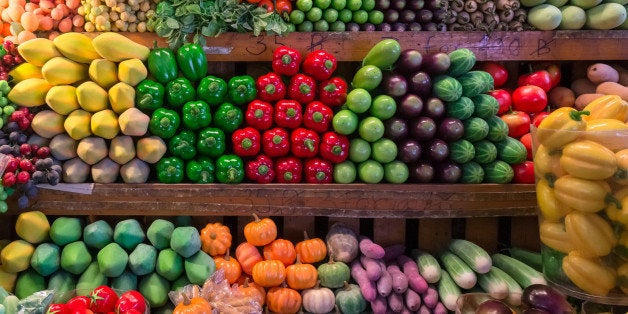
We see the problems in our lives and in the world and ask, "What can we do?" The answer is, "We're doing it now." Whether we like it or not, or know it or not, our small actions repeated day after day add up to huge impacts. Consumers weigh in on a vast array of issues every day.
As for any species, from microorganisms on up, food is at the heart of our lives and how we fit into the web of life. Our eating habits profoundly affect our individual health and well-being; our social, economic, and political systems; and our environment. Our future success as a species may hinge on our food habits.
Diet is a significant factor in three of the major causes of death in the U.S.--heart disease, cancer, and stroke, which account for more than half of all deaths--as well as diabetes, hypertension, obesity, osteoporosis, and nonalcoholic fatty liver disease, which affects one-third of Americans. Food allergies can lead to a whole host of "mental" symptoms, including fatigue, "brain fog," slowed thought processes, irritability, agitation, aggressive behavior, anxiety, depression, schizophrenia, hyperactivity, autism, learning disabilities and dementia.
Americans spend 18 percent of gross domestic product (GDP) on health care, a percentage that may reach 30 percent. Obesity alone accounts for 21 percent of U.S. health care costs. Yet politicians largely ignore a major root cause of skyrocketing health care costs--our disastrous diet--as revealed in the documentary film Fed Up!, which is scheduled for release on May 9. Most of the work doctors do wouldn't be necessary if people took care of their own health, in particular, by eating a healthy diet.
The food industry wields immense political power in the U.S. through political campaign contributions and other means. The government paid out $256 billion in farm subsidies from 1995 through 2012. "We subsidize large agribusiness and the wealthy at the expense of the family farmer and the taxpayer," says U.S. Congressman Paul Ryan, who describes the practice as "an egregious example of cronyism."
The U.S. food industry has defeated efforts to require food labels that disclose genetically modified (GM) ingredients, even though 64 other countries already require such disclosure. Food choice is democracy in action, giving ordinary citizens a potentially enormous amount of power, including veto power. Industrial food producers in the U.S. know this, and by aggressively fighting food labeling campaigns they are doing their best to make it difficult for consumers to choose.
Our food choices influence whether we protect or devastate our environment and our fellow species. Approximately 38 percent of the world's ice-free land is dedicated to raising crops and livestock, and the clearing of grasslands and forests for agriculture is a major driver of wildlife extinction. As much as half of all the food produced in the world ends up being thrown away. Only 55 percent of world crop calories feed people; 36 percent feeds livestock and 9 percent is used for biofuels and industrial products. Livestock production requires vastly more water, land, and energy than plant foods and is a major cause of the world's most pressing environmental problems, including global warming, land degradation, air and water pollution, and loss of biodiversity.
Our present style of industrial agriculture emits more climate-disrupting greenhouse gases than transportation does. Industrial agriculture applies excess nutrients, which end up in groundwater, rivers and oceans. Nutrient-caused oxygen depletion has created more than 400 dead zones in the world's oceans, some as large as New Jersey. Industrial agriculture practices cause us to lose precious topsoil 17 times faster than new topsoil is formed. They deplete organic carbon and micronutrients in soil and contaminate soil and water with pesticides and herbicides--chemicals that kill wildlife, including vital pollinators such as birds, bees, and butterflies. Almost 90 percent of all plant species, including 75 percent of crop plants, rely on animals for pollination. Wasteful agricultural practices deplete finite water resources; as much as 60 percent of the water diverted or pumped for irrigation is wasted.
Consumers' food choices can influence whether crop-pickers make a decent wage or are consigned to lives of poverty and chemical exposure. Consumers' choices can help determine whether small farmers in India can enjoy a decent life, or whether to continue unworkable agricultural policies and practices such as those that have driven 250,000 Indian farmers to commit suicide since the mid-1990s.
We subject industrial farm animals to tormented lives in unsanitary, crowded conditions, sustained by antibiotics. We hide this inhumane treatment using "ag gag" laws (another sign of food industry clout) that criminalize taking photographs of "concentrated animal feeding operations."
The U.S. has lost 93 percent of its agricultural genetic diversity over the last 80 years, as a handful of agricultural corporations have taken increasing control of our seed supply, threatening the resiliency of our food supply to withstand challenges such as climate disruption.
Although studies variously prove or disprove that short-term organic and industrial food yields are similar, industrial agriculture cannot deliver over the long term due to its negative impacts on soil, water, air, pollinators and seed biodiversity.
Now, the good news: The problems described above are largely reversible, and solutions to them already exist. Organic outperformed industrial yields in 30-year-long side-by-side trials growing organic and industrial corn and soy, while emitting less climate-damaging greenhouse gases, using less energy and water, decreasing erosion and groundwater pollution, and enhancing soil quality and biological resources. With a shift to organic farming practices, agriculture could become carbon neutral.
The biggest hurdle for organics is the added cost of sustainable practices. If the indirect costs of industrial food production--such as the impact on public health of chemicals released into our air and water--were factored in, industrial food would not enjoy a price advantage. Currently, citizens pay for the health and environmental damages of industrial agriculture, not the food industry. While the unfair advantage of massive public subsidies provided to industrial food producers persists, healthy food is largely out of economic reach for poor people. Nevertheless, the health care costs of forcing poor people to eat unhealthy food will be paid, one way or another.
For people who aren't poor, changing diet is easy and sustainable. Healthy food tastes good and makes its consumers feel good.
Americans spend 14 percent of GDP on groceries and restaurants. Most of us need or want others to provide our food. The food industry, which just wants to make money, need not fear that it will go out of business; it can thrive by providing healthy foods produced by sustainable, ethical methods. In a perfect union of interests, if consumers demand healthy, sustainably produced food, the food industry will provide it.
We make a difference with each bite we take, and by reducing food waste. By choosing whole, real, organically grown food--preferably favoring plant foods--we vote for everyone's health, including our own. We also help the economy by reducing health care and environmental costs.
